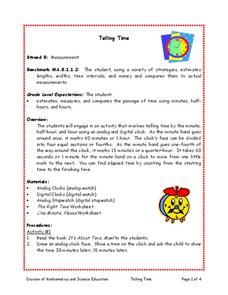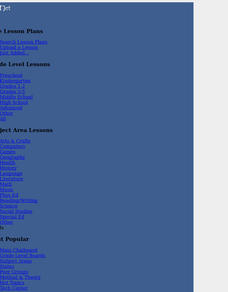Curated OER
Scarcity, Choice and Decisions
Students study the basic economic trilogy (scarcity, choice, and costs). For this money management lesson, students use a scenario of a High School Prom to calculate how scarcity, choice and cost apply by completing provided worksheets...
Curated OER
Probability in Daily Life
Sixth graders examine the use of probability in daily life. In this probability lesson, 6th graders listen to scenarios from Louis Sachar's, Holes, after discussing probability in everyday life. They pretend they are detectives who are...
Curated OER
Barter and Trade
Students explore the concepts of bartering and trading. In this algebra lesson, students barter with each other for different items. They use special cards to designate ownership of an item as they explore the complexity of bartering.
Curated OER
Heads or Tails
Seventh graders compare experimental and theoretical probabilities. In this comparing experimental and theoretical probabilities lesson, 7th graders discuss the theoretical probability of flipping a coin. Students flip a coin 25 times...
Curated OER
Keystone Science School: Sustainable Automobiles
Students explore how to choose the correct car for them based on their needs.
Curated OER
Lemonade for Sale
Third graders engage in a read-aloud of the book, "Lemonade for Sale." They collect data from the story and turn the data into a mathematical graph. This lesson has a rubric for you and the students to follow-very creative lesson.
Curated OER
Teddy Bears Everywhere
Learners explore the history of teddy bears. In this comprehension lesson, students bring a bear of their own to compare and contrast with their classmates. Learners read book and discuss the events and draw pictures of the scenes.
Curated OER
Making Cookies- How many per hour?
Fifth graders measure how long it takes to make cookies. In this measuring time activity, 5th graders explore how to manage time. Students decide when to start making breakfast on time, how to calculate playing time into their lunch...
Curated OER
Not Everything is More Expensive
Students compare prices and determine percent increases and decreases of items in order to make wise purchases. In this percent increases and decreases lesson plan, students calculate the amounts based on grocery store ads.
Curated OER
Play the Market
Young scholars participate in a hypothetical experiment. For four weeks, they track 10 stocks they have selected. They discuss their imaginary gains and losses and share their observations about the stock market, and their reactions to...
Curated OER
Telling Time
Students estimate, measure, and compare the passage of time using minutes, half hours, and hours. They read the book 'It's About Time, Max!' with the teacher and draw an analog clock face. They show the time and 30 minutes later, 15...
Curated OER
Money Management Intelligence
Learners follow directions to help a client with his/her budget. After selecting their client, they download confidential data and listen to the challenge presented on the website. They adjust the budgets as needed. Then, they click play...
Curated OER
Percents: (An Application to Real Life Problems)
Seventh graders explore the concept of calculating percents. In this calculating percents lesson, 7th graders simulate ordering food off of a menu. Students work in groups to calculate the bill, tax, and the tip for the...
Curated OER
Grammar Reviewing Using A Sentence Auction
Students participate in an auction game in which they buy as many correct sentences as they can with an imaginary $3000. In this grammar activity, students determine which sentences are correct and buy as many sentences as possible,...
Curated OER
Cartesian Coordinates
Students investigate rational numbers through data analysis and statistics. In this algebra instructional activity, students represent, rename, compare and order rational numbers. They collect and represent data correctly on a graph.
Curated OER
Investigation So What's The Difference?
First graders investigate the differences between shapes. In this block characteristics lesson, 1st graders work in groups to explore blocks, group the blocks by different characteristics, discuss the block attributes and record their...
Curated OER
You Bet!
Learners explore the mathematical probabilities involved in gambling and how these factors affect people's behavior. They work in pairs and conduct and experiment pertaining to blackjack. The class creates a graph showing the trends found.
Curated OER
It's a Sale!
Students make good decisions about making purchases of items on sale and explain how percentages effect cost.
Curated OER
1, 2, 3 Hooray for Number Equivalency!
Young scholars represent equivalent amounts using concrete materials, number symbols, and number words.
Curated OER
Tomb Robbers
Sixth graders examine benchmark angles embedded into a circle grid and examine how grid systems do not always have to be square. the game "Tomb Robbers" is used to develop strategies.
Curated OER
Charting Historical Gas Prices
Learners investigate the historical and current prices of a gallon of gasoline. Using an online tool, they calculate the inflation-adjusted cost of gasoline over the years, and create a graph to demonstrate the actual cost vs. the...
Curated OER
Coin Codes
Students work on cracking coin codes in honor of the Navajo Code Talkers Medal. Students review the handout on Crack the Code. Students race to see who can crack the code the fastest.
Curated OER
A Newspaper?
Sixth graders use newspapers to investigate fractions. They work in small groups to categorize articles, measure them with the grid transparency, and calculate the values represented. Afterward, they write a reflective essay on the role...
Curated OER
Tomb Robbers
Sixth graders identify benchmark angles as they are embedded into a circle grid. They observe the teacher using an angle ruler and complete a Star Spangled worksheet, play the game Tomb Robbers, and as a class discuss their game winning...

























